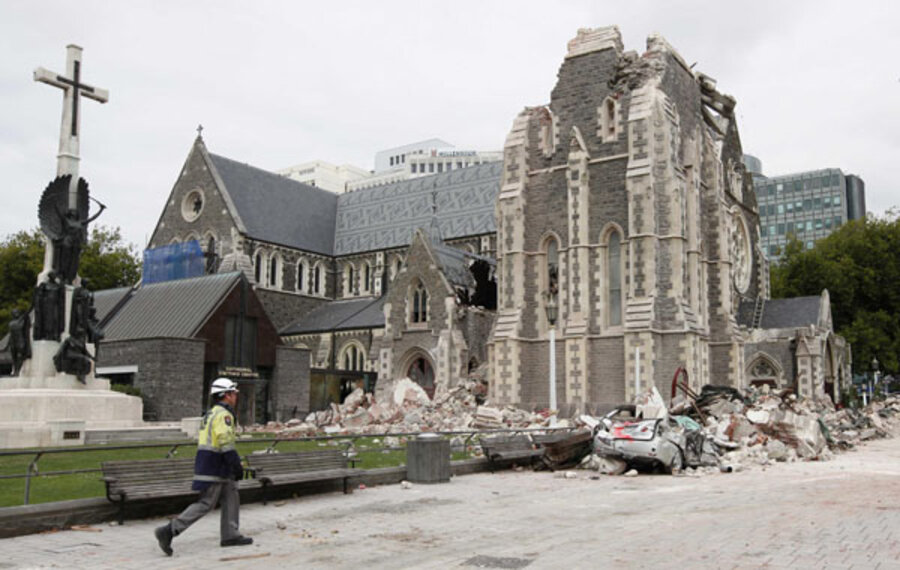Christ Church Cathedral a flashpoint for quake-hit New Zealand town
Loading...
| Wellington, New Zealand
When New Zealand's most devastating earthquake in 80 years struck Christchurch in 2011 the toppled bell tower and rock-strewn lawn of the city's iconic cathedral became a powerful symbol of the scale of devastation.
Today, nearly three years later, the media crews have long departed but the cathedral looks nearly identical.
In some ways the 132-year old cathedral, which was the city's namesake and long served as its architectural centerpiece, has emerged as a proxy in the debate over how best to rebuild from the 6.3 magnitude temblor that killed 185 and caused an estimated $30 billion worth of damage.
Few dispute that the edifice is "far more than just a building," in the words of Alex Bremner, a senior lecturer in architectural history at Edinburgh University in Scotland, who has written extensively about it. But opinion is sharply divided on how the city should recreate its stairway to heaven.
The cathedral is frozen in its 2011 state as a legal battle works its way through the New Zealand courts over whether the building should be restored or torn down and completely redesigned. The church wants to tear down and rebuild. A group of American supporters and local activists want it restored.
Christchurch reconstruction
There are similar debates across Christchurch, New Zealand's second-largest city. While the government created a national agency to oversee reconstruction, there have been legal battles over everything from the creation of a red zone that closed the city center for 857 days, to property owners' claims against insurance companies.
Roughly 3.5 percent of the city's population left after the earthquake, according to government statistics, and more than 17,000 homes were ruled to be in the red zone or uninhabitable. Half of the buildings in the city's center were demolished and the number of homeless may have doubled during that period, according to the Ministry of Business, Innovation and Employment.
The Canterbury Earthquake Recovery Authority (CERA) has outlined a plan for a bustling new center, with a vibrant restaurant and nightlife. It also plans on building a major sports facility and a cricket oval that will host matches during the 2015 cricket world cup. This past year the population increased slightly in Christchurch for the first time since the earthquake.
CERA has not weighed in on their preference for the future of the Christ Church Cathedral, which, in whatever architectural style it takes, will remain at the heart of the city center. Last month the New Zealand Supreme Court declined to hear one of three cases about the Cathedral, allowing the church¹s plans for demolition and rebuilding in a new, modern style to proceed for now. Future legal action in one of the other cases could reverse the decision.
Restoration advocates
Those who oppose the court ruling, and who brought all three legal suits, aren't giving up hope.
One of the biggest advocates of a restoration of the cathedral to its former Gothic Revival style is Marcus Brandt, an American and self-described Kiwiphile who has adopted New Zealand as a kind of second cultural home after a few visits to the country.
The idea for restoration first came to him as he sat glued to his computer screen watching reports of the initial carnage. As he watched, Mr. Brandt's thoughts went to the Amish barn-raising ceremonies in his native Pennsylvania and the powerful role these events can sometimes play in binding together a community.
Brandt, a master carpenter and stonemason and instructor on traditional building skills at Lehigh University in Bethlehem, Pa., joined forces with The Christchurch Buildings Trust, a group of citizens who want to restore the significant buildings in the city in general, and the cathedral in particular.
Brandt and the Trust propose rebuilding the cathedral through donated services from master builders around the world. Scores of stained glass artisans, timber frame carpenters, and stonemasons from Britain, Canada, and the US, the trust says, have already agreed to do pro-bono work to help prefabricate the heavy timber sections of the steeple.
The trust is headed by two former national politicians and old political foes, Jim Anderton and Philip Burdon, who have joined forces, they say, out of a love for their city's heritage and because they believe Brandt's offer is too good to refuse. [Editor's note: The original version of this story misspelled Philip Burdon's last name.]
"It's utterly unique," Mr. Burdon says, "for a group to be offering the city something as special as this only to have had the gesture thwarted."
A different vision
Leaders of the cathedral have a different vision. The church has declined Brandt's proposal and its bishop, Victoria Matthews, says she wants to see the landmark edifice replaced with an entirely contemporary new building, which the church believes will be safer, less expensive, and better in tune with the times. Public-opinion surveys suggest at least half the city may be with her.
Matthews did not respond to an interview request. In a statement, she welcomed the latest decision, saying that the church was "grateful to be able to move forward with our plans."
In the meantime, Christ Church Cathedral congregants are holding services in a $6 million "cardboard cathedral" in nearby Latimer Square. The building, made from 98 giant cardboard tubes coated with waterproof polyurethane, uses stained glass from the original structure, and is built to last for more than a decade.







